A Historical Discovery:
The Restoration of a Funerary Couch
This
marble Funerary Couch, thought to have been excavated in northern Chi na,
was created approximately 1,500 years ago to be placed underneath a coffin
at a funeral. As a ceremonial object, it indicates the special status of the
dead in the next world. The eleven panels in the Miho Museum's collection
depict scenes of a Zoroastrian funeral ceremony, a marriage ceremony, and
a hunt. as well as a dance scene in a deeply carved relief that provides us
with an excellent view of the spiritual life of the people of the day. Although
northern China was rather unstable politically during this period, the area
was invigorated by the trade that began to develop with countries to the west
along the Silk Road, making it a popular place to visit for people such as
foreign envoys, merchants, and Buddhist priests.
The images can also be thought of as something like
genre paintings depict ing the exchange between the East and West. Like a
time machine, they seem to transport us back to that period in northern China.
At the time the Miho Museum acquired these panels, it was unclear whether
they were sections of a coffin stand or parts of a pair of gateposts, nor
was it known how they were assembled. Finally, as the result of a long period
of study and analysis by Dr.Pieter Meyers, head of the conservation center
at the Los Angeles County Museum of Art, and his staff, the way in which these
panels were joined to form a single coffin-stand screen became clear. Dr.
Meyers and his staff also beautifully restored the illustrations on the upper
part of this work. The success of this project was largely due to meticulous
examinations of the shapes of the iron fittings on the reverse of the panels,
the measurement of their positions, the condition of the stone area that had
once been fitted together, and a careful inspection of the coloring. After
this had been determined, the team went forward with further surveys of the
panels, making it possible for the panels to be exhibited at Miho Museum's
Autumn Exhibition in a manner that more closely approximates the original
form.
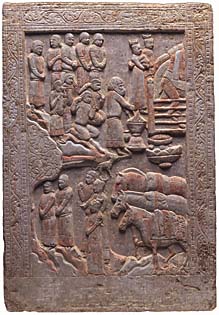
A scene of funeral
rite
In
the center of the upper part, a Zoroastrian priest stands before a fire altar
wearing the white veil. To his side is a dog. In this rite, the dog is made
to look at the body of the deceased, since its gaze to drive away the sprit
of defilement.
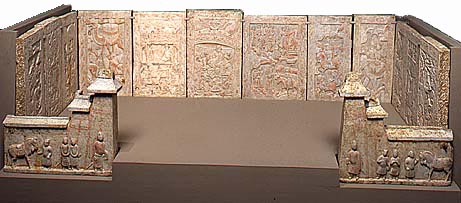
Funerary Couch
China, Northern Dynasties - Sui Dynasties Second half of 6th-early 7th Century A. D.
[September 1 through December 15]
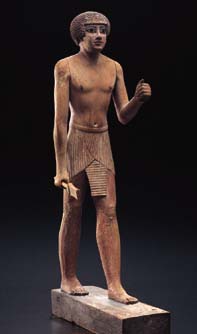
Statuette of Wepay
Egypt, probably
from Asyut, Dynasty 12, 19th century BC
The
ancient Egyptians carved the human form in a beautifully youthful way as a
host for the ka or "spirit" of the deceased. This example of a ka statuette,
with its gentle facial expression, gives one the impression of the great and
benevolent power of life that seems to come from the heart of this figure.
[September 1 through December
15]
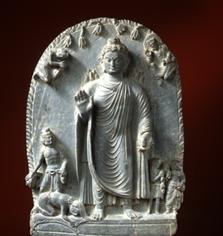
Relief of the Dipamkara
Afghanistan,
3rd-4th century AD
Sumati,
a young disciple of Baramon in a past life, prostrates himself on the ground
and spreads his hair for Dipamkara to walk over so as not to get his feet
soiled by dirty water. He was imparted with a prophecy that he would become
enlightened in the future. This relief depicts Shyakamuni's life in the past
world.
[September 1 through December
15]
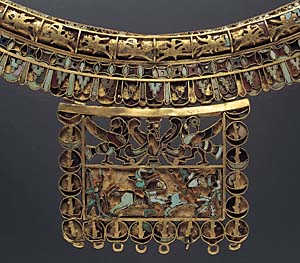
Torque (Pectoral) with a Pendant
Iran, Achaemenid
period, mid-6th-4th century BC
An
international style in the art of luxury objects prevailed in the Archa emenid
Empire. With the lavish use of gold and inlays of colorful stone and glass
employed in creating this torque, the piece can be considered an excellent
example of the flowering of the jeweler's art during this period.
[September 1 through December
15]

Female Figure
East Mediterranean,
about mid-2nd millennium BC
The
woman portrayed in this work, with body turned up and hands held high, is
worshipping a manifestation of a god in the air. This figure closely resembles
the sensual, vivacious female figures depicted on the mural paintings that
decorated a contem-porary palace in Crete.
[November 3 through December
15]
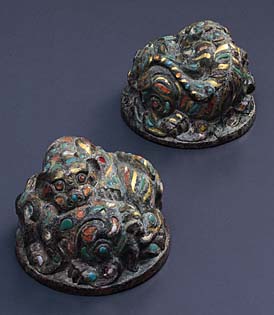
Set of Mat Weights
China,
early Han dynasty,
2nd century BC
On
each of these pieces, a feisty tiger betters a prone bear. Despite the fact
that these objects had a practical function, to anchor the corners of a woven
mat, there is something remarkable in both the realistic portrayals of the
scenes and their ornamentation.
[September 1 through December 15]